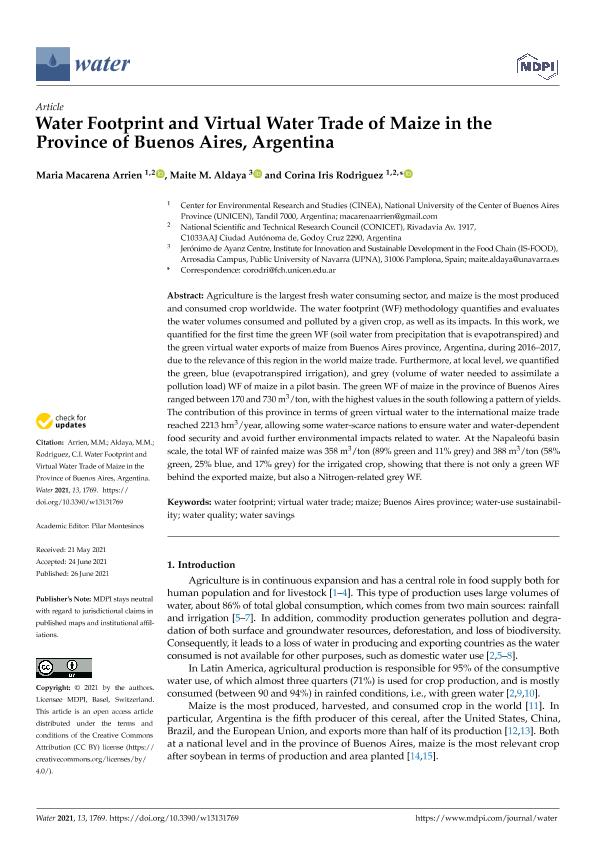Mostrar el registro sencillo del ítem
dc.contributor.author
Arrien, Macarena

dc.contributor.author
Aldaya, Maite M.
dc.contributor.author
Rodriguez, Corina Iris

dc.date.available
2022-08-08T15:47:37Z
dc.date.issued
2021-06
dc.identifier.citation
Arrien, Macarena; Aldaya, Maite M.; Rodriguez, Corina Iris; Water footprint and virtual water trade of mize in the province of Buenos Aires, Argentina; Multidisciplinary Digital Publishing Institute; Water; 13; 13; 6-2021; 1-16
dc.identifier.uri
http://hdl.handle.net/11336/164579
dc.description.abstract
Agriculture is the largest fresh water consuming sector, and maize is the most produced and consumed crop worldwide. The water footprint (WF) methodology quantifies and evaluates the water volumes consumed and polluted by a given crop, as well as its impacts. In this work, we quantified for the first time the green WF (soil water from precipitation that is evapotranspired) and the green virtual water exports of maize from Buenos Aires province, Argentina, during 2016–2017, due to the relevance of this region in the world maize trade. Furthermore, at local level, we quantified the green, blue (evapotranspired irrigation), and grey (volume of water needed to assimilate a pollution load) WF of maize in a pilot basin. The green WF of maize in the province of Buenos Aires ranged between 170 and 730 m3/ton, with the highest values in the south following a pattern of yields. The contribution of this province in terms of green virtual water to the international maize trade reached 2213 hm3/year, allowing some water-scarce nations to ensure water and water-dependent food security and avoid further environmental impacts related to water. At the Napaleofú basin scale, the total WF of rainfed maize was 358 m3/ton (89% green and 11% grey) and 388 m3/ton (58% green, 25% blue, and 17% grey) for the irrigated crop, showing that there is not only a green WF behind the exported maize, but also a Nitrogen-related grey WF.
dc.format
application/pdf
dc.language.iso
eng
dc.publisher
Multidisciplinary Digital Publishing Institute
dc.rights
info:eu-repo/semantics/openAccess
dc.rights.uri
https://creativecommons.org/licenses/by/2.5/ar/
dc.subject
BUENOS AIRES PROVINCE
dc.subject
MAIZE
dc.subject
VIRTUAL WATER TRADE
dc.subject
WATER FOOTPRINT
dc.subject
WATER QUALITY
dc.subject
WATER SAVINGS
dc.subject
WATER-USE SUSTAINABILITY
dc.subject.classification
Ciencias Medioambientales

dc.subject.classification
Ciencias de la Tierra y relacionadas con el Medio Ambiente

dc.subject.classification
CIENCIAS NATURALES Y EXACTAS

dc.title
Water footprint and virtual water trade of mize in the province of Buenos Aires, Argentina
dc.type
info:eu-repo/semantics/article
dc.type
info:ar-repo/semantics/artículo
dc.type
info:eu-repo/semantics/publishedVersion
dc.date.updated
2022-08-04T15:09:51Z
dc.identifier.eissn
2073-4441
dc.journal.volume
13
dc.journal.number
13
dc.journal.pagination
1-16
dc.journal.pais
Suiza

dc.journal.ciudad
Basilea
dc.description.fil
Fil: Arrien, Macarena. Consejo Nacional de Investigaciones Científicas y Técnicas. Centro Científico Tecnológico Conicet - Tandil; Argentina. Universidad Nacional del Centro de la Provincia de Buenos Aires. Facultad de Ciencias Humanas. Departamento de Ciencias Ambientales. Centro de Investigación y Estudios Ambientales; Argentina
dc.description.fil
Fil: Aldaya, Maite M.. Universidad Pública de Navarra; España
dc.description.fil
Fil: Rodriguez, Corina Iris. Consejo Nacional de Investigaciones Científicas y Técnicas. Centro Científico Tecnológico Conicet - Tandil; Argentina. Universidad Nacional del Centro de la Provincia de Buenos Aires. Facultad de Ciencias Humanas. Departamento de Ciencias Ambientales. Centro de Investigación y Estudios Ambientales; Argentina
dc.journal.title
Water
dc.relation.alternativeid
info:eu-repo/semantics/altIdentifier/url/https://www.mdpi.com/2073-4441/13/13/1769
dc.relation.alternativeid
info:eu-repo/semantics/altIdentifier/doi/http://dx.doi.org/10.3390/w13131769
Archivos asociados
